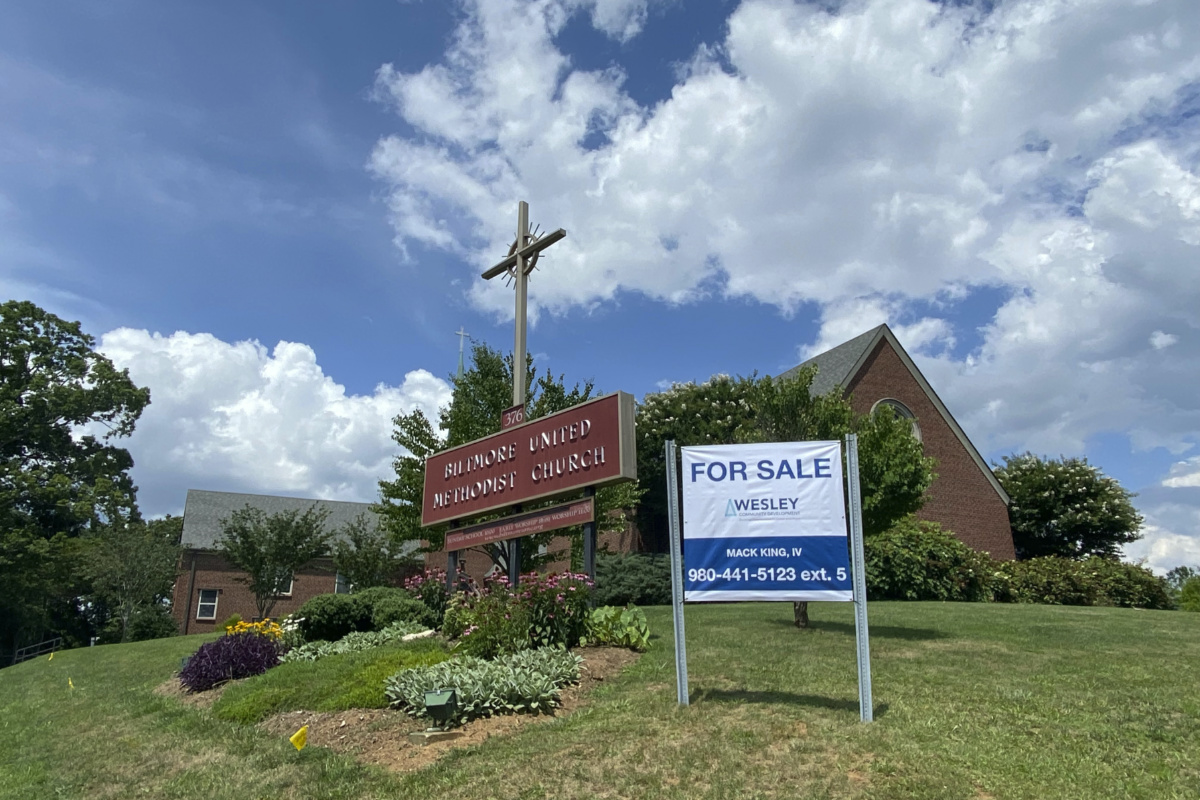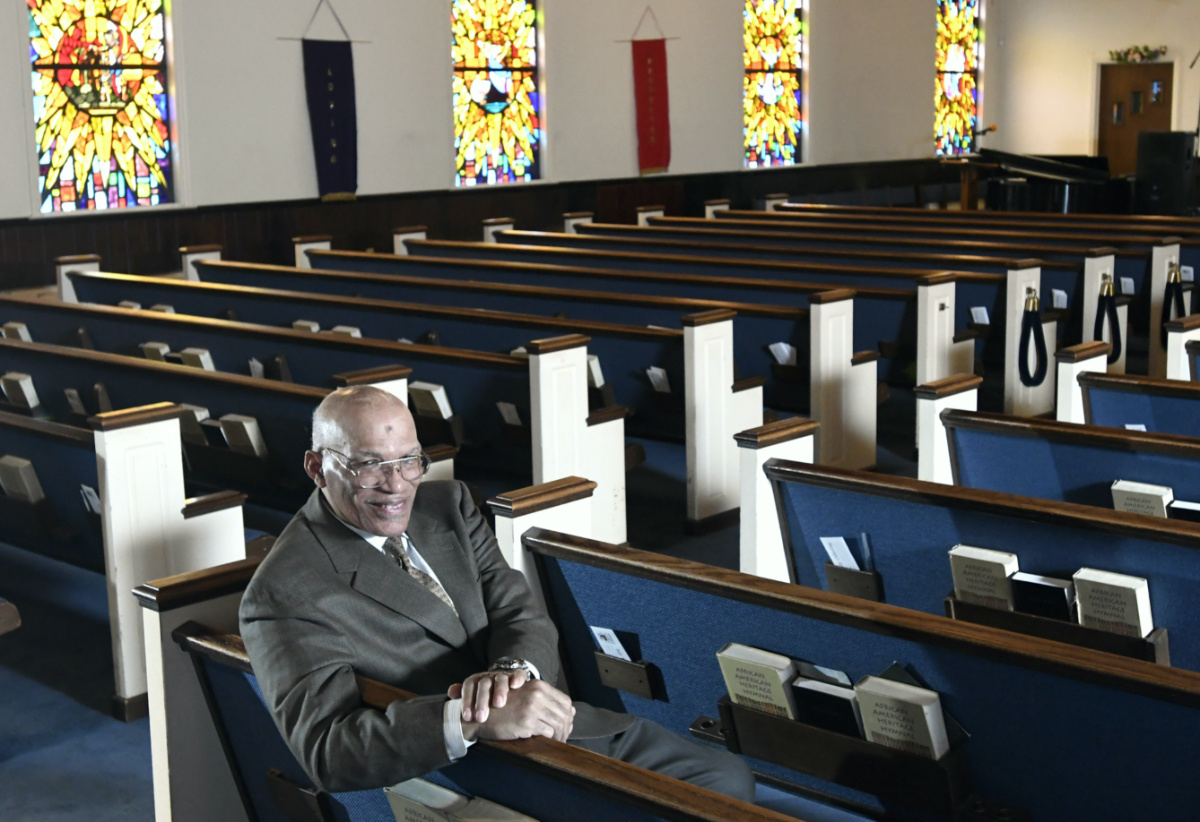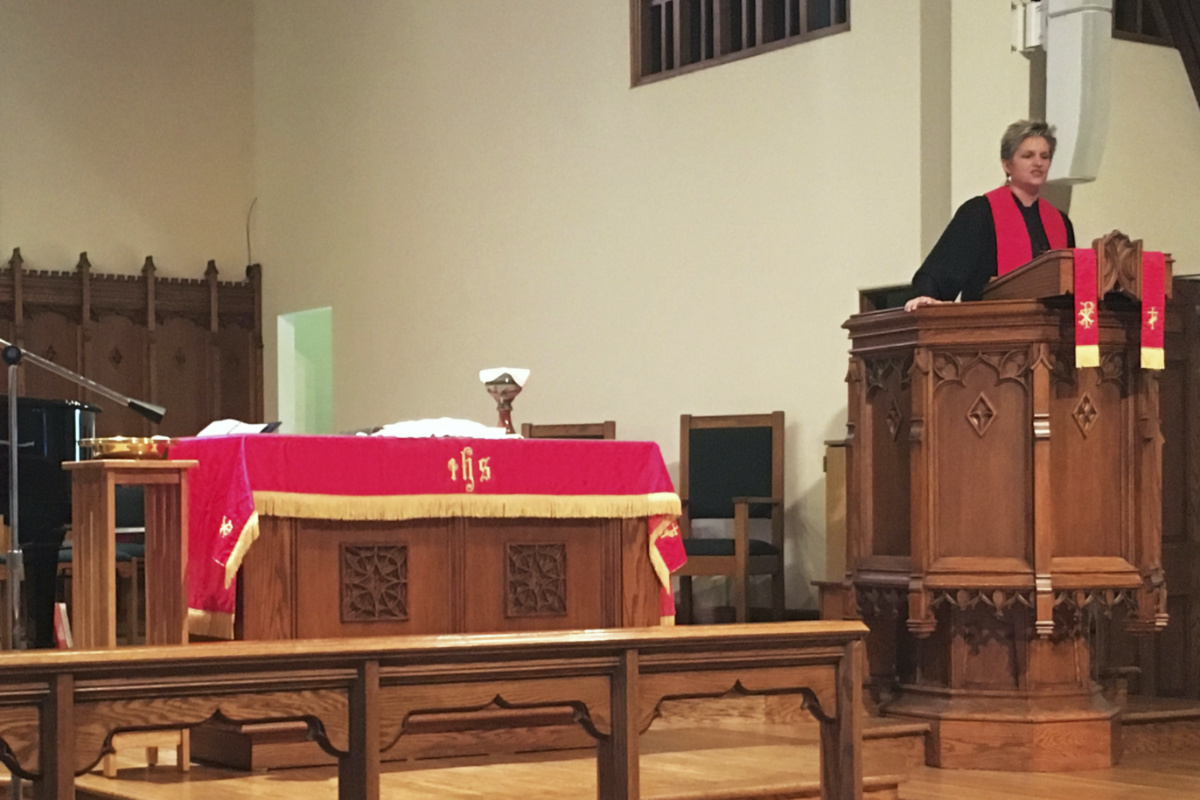
HOLLY MEYER and HALELUYA HADERO, of The Associated Press, report on the financial stresses facing US churches…
Biltmore United Methodist Church of Asheville, North Carolina, is for sale.
Already financially strapped because of shrinking membership and a struggling preschool, the congregation was dealt a crushing blow by the coronavirus. Attendance plummeted, with many staying home or switching to other churches that stayed open the whole time. Gone, too, is the revenue the church formerly got from renting its space for events and meetings.
“Our maintenance costs are just exorbitant,” said Rev Lucy Robbins, senior pastor. “And we just don’t have the resources financially that we used to have to be able to do the kind of ministry work that we would like.”

This photo provided by Rev Lucy Robbins shows a “For Sale” sign in front of the Biltmore United Methodist Church in Asheville, North Carolina in July, 2021. Already financially strapped because of shrinking membership and a struggling preschool, the congregation was dealt a crushing blow by the coronavirus. Attendance plummeted, with many staying home or switching to other churches that stayed open the whole time. Gone, too, is the revenue the church formerly got from renting its space for events and meetings. PICTURE: Rev Lucy Robbins via AP.
Biltmore is just one of an untold number of congregations across the country that have struggled to stay afloat financially and minister to their flocks during the pandemic, though others have managed to weather the storm, often with help from the Federal Government’s Paycheck Protection Program, or PPP, and sustained levels of member donations.
The coronavirus hit at a time when already fewer Americans were going to worship services – with at least half of the nearly 15,300 congregations surveyed in a 2020 report by Faith Communities Today reporting weekly attendance of 65 or less – and exacerbated the problems at smaller churches where increasingly lean budgets often hindered them from things like hiring full-time clergy.
“The pandemic didn’t change those patterns, it only made them a little bit worse.”
– Scott Thumma, director of the Hartford Institute for Religion Research and co-chair of Faith Communities Today.
“The pandemic didn’t change those patterns, it only made them a little bit worse,” said Scott Thumma, director of the Hartford Institute for Religion Research and co-chair of Faith Communities Today.
Attendance has been a persistent challenge. As faith leaders moved to return to in-person worship, first the highly transmissible delta variant and now the even faster-spreading omicron have thrown a wrench into such efforts, with some churches going back online and others still open reporting fewer souls in the pews.
At Biltmore, for example, attendance at weekly services are down from around 70 pre-pandemic to just about 25 today, counting both in-person and online worship.
After congregants voted last May to put the church property, a two-building campus perched on a verdant knoll just off Interstate 40, on the market, church leaders are still figuring out what comes next, including where the congregation will call home. But they hope to use some of the proceeds from the property sale to support marginalised communities and causes like affordable housing.
Unlike Biltmore, Franklin Community Church, about 32 kilometres outside of Nashville, Tennessee, doesn’t have its own sanctuary, holding services instead at a public school. That turned out to be a blessing during the pandemic, with no need to worry about a mortgage, upkeep, insurance or utilities.
“We wouldn’t have survived if we’d had all that,” said Rev Kevin Riggs, the church’s pastor.
Still, it has been a battle. During the 15 months that services at Franklin went online-only, some members left for other congregations or got out of the habit of giving, according to Riggs. Weekly attendance is down from around 100 to less than 40, and the omicron spike recently forced the church to go virtual again.
The impact is felt in the collection plate: The money coming in now is just about a third of what it was before the pandemic, the pastor said. The church has cut spending where it could, turned to grants to try to make up the difference and worked to raise more money from community members who don’t attend but support the church’s ministries, such as serving homeless people.
“We’re surviving…But we have felt the hurt,” Riggs said.

Rev Alvin J Gwynn, Sr, of Friendship Baptist Church in Baltimore, sits in his church’s sanctuary, on Thursday, 19th March, 2020. Amid the coronavirus pandemic, the predominantly Black church received a PPP loan of more than $US55,000, but that barely made a dent in expenses. Gwynn has given up his pastor’s salary and for now is living off Social Security checks and his other job in construction. PICTURE: AP Photo/Steve Ruark/File photo.
Another struggling congregation, Friendship Baptist Church in Baltimore, is essentially living week to week. The predominantly Black church received a PPP loan of more than $US55,000, but that barely made a dent in expenses. Rev Alvin Gwynn, Sr, has given up his pastor’s salary and for now is living off Social Security checks and his other job in construction.
Slumping attendance has hurt the bottom line there, as elsewhere. Friendship Baptist counts around 900 active members but only about 150 of them are showing up, making their donations especially crucial.
The church is “surviving because of the sacrificial giving of the 150,” said Gwynn, who doesn’t intend to start drawing a paycheck again until the church is stable. “They give way, way more than a normal offering each Sunday individually.”
During the pandemic, experts said many congregations embraced online giving, which could boost contributions by $US300 per person annually, according to The Faith Communities Today report.
More broadly, various other surveys and reports show a mixed picture on congregational giving nationwide.
Gifts to religious organizations grew by one per cent to just over $US131 billion in 2020, a year when Americans also donated a record $US471 billion overall to charity, according to an annual report by GivingUSA. Separately, a September survey of 1,000 protestant pastors by the evangelical firm Lifeway Research found about half of congregations received roughly what they budgeted for last year, with 27 per cent getting less than anticipated and 22% getting more.
Hope Presbyterian Church in Austin, Texas, a largely upper-middle-class congregation of about 400, is among those that have enjoyed relative stability despite the pandemic.
Rev Josh Robinson had expected contributions to drop off when in-person services paused for more than a year, but they remained steady. So have member pledges for upcoming gifts in 2022. Some in the congregation even donated their government stimulus checks to the church, which used them to set up a fund to provide direct financial assistance to those who lost income due to the pandemic.
We rely on our readers to fund Sight's work - become a financial supporter today!
For more information, head to our Subscriber's page.
It all prompted the pastor to reexamine his own approach to the pandemic.
“I needed to step back and think, what did it mean for me as a spiritual leader to not have the same faith mindset, since I was anticipating a downturn?” Robinson said. “Here were the members of the church stepping up — I had to lean into that. And rightfully, I was able to do so with great joy.”
Even before, the church had embraced frugality in order to pay down its debt, which has fallen from $US2 million in 2013 to less than $US300,000 today.
When services went virtual, savings on utilities and other costs helped keep the budget balanced. PPP loans of some $US290,000 were also key to maintaining employees on the payroll and offsetting lost revenue from renting out space and other services.

In this photo provided by Rev Lucy Robbins, she speaks during a service at the Biltmore United Methodist Church in Asheville, North Carolina, in October, 2018. “Our maintenance costs are just exorbitant,” said the Rev. Lucy Robbins, senior pastor. “And we just don’t have the resources financially that we used to have to be able to do the kind of ministry work that we would like.” PICTURE: Rev Lucy Robbins via AP.
At West Harpeth Primitive Baptist Church, another church in Franklin, giving is down but only slightly. Hewitt Sawyers, the pastor, attributes that to the scant turnover among the more than 150-year-old historically Black congregation’s members, many of whom are committed to financially supporting the church and work in sectors that were less damaged by the pandemic than others.
“We’ve just been wonderfully, wonderfully blessed,” Sawyers said.
Budget projections for this year are rosy enough that West Harpeth leaders are hopeful they can tackle a needed building renovation.
“We are extremely optimistic about it,” Sawyers said. “We’re planning on trying to do that in ’22, and we feel very, very, very comfortable about trying to get that done.”






